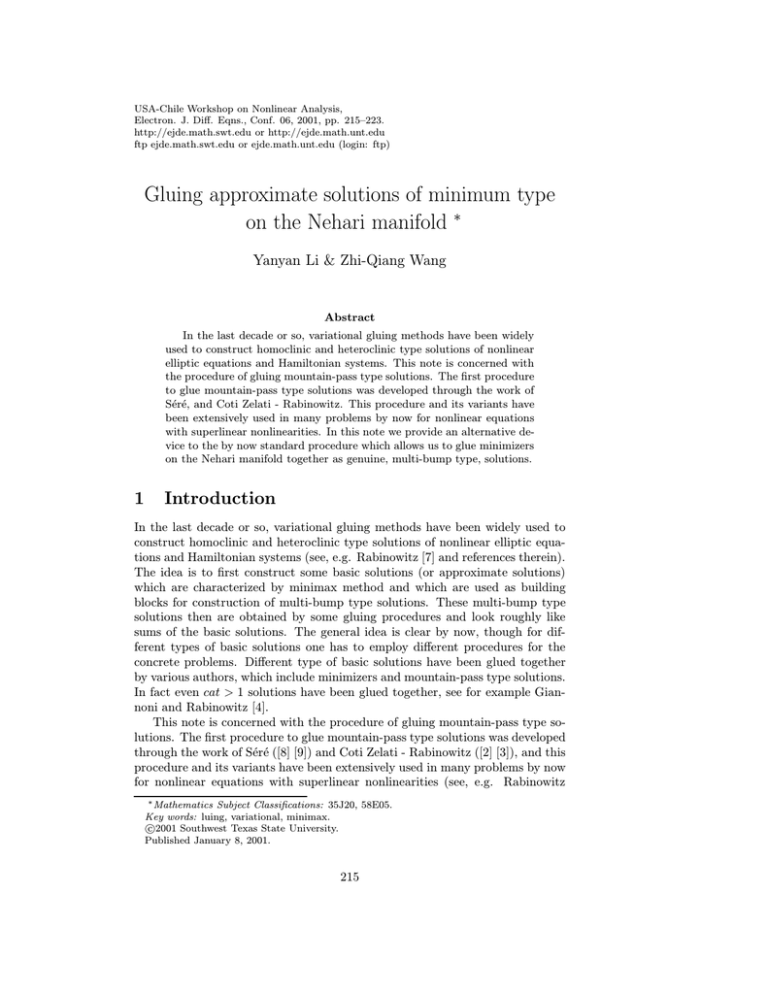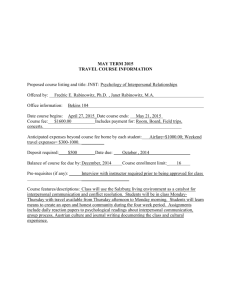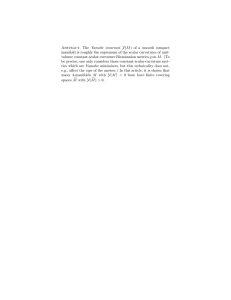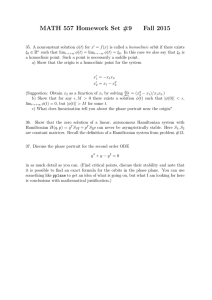Document 10773364
advertisement

USA-Chile Workshop on Nonlinear Analysis,
Electron. J. Diff. Eqns., Conf. 06, 2001, pp. 215–223.
http://ejde.math.swt.edu or http://ejde.math.unt.edu
ftp ejde.math.swt.edu or ejde.math.unt.edu (login: ftp)
Gluing approximate solutions of minimum type
on the Nehari manifold ∗
Yanyan Li & Zhi-Qiang Wang
Abstract
In the last decade or so, variational gluing methods have been widely
used to construct homoclinic and heteroclinic type solutions of nonlinear
elliptic equations and Hamiltonian systems. This note is concerned with
the procedure of gluing mountain-pass type solutions. The first procedure
to glue mountain-pass type solutions was developed through the work of
Séré, and Coti Zelati - Rabinowitz. This procedure and its variants have
been extensively used in many problems by now for nonlinear equations
with superlinear nonlinearities. In this note we provide an alternative device to the by now standard procedure which allows us to glue minimizers
on the Nehari manifold together as genuine, multi-bump type, solutions.
1
Introduction
In the last decade or so, variational gluing methods have been widely used to
construct homoclinic and heteroclinic type solutions of nonlinear elliptic equations and Hamiltonian systems (see, e.g. Rabinowitz [7] and references therein).
The idea is to first construct some basic solutions (or approximate solutions)
which are characterized by minimax method and which are used as building
blocks for construction of multi-bump type solutions. These multi-bump type
solutions then are obtained by some gluing procedures and look roughly like
sums of the basic solutions. The general idea is clear by now, though for different types of basic solutions one has to employ different procedures for the
concrete problems. Different type of basic solutions have been glued together
by various authors, which include minimizers and mountain-pass type solutions.
In fact even cat > 1 solutions have been glued together, see for example Giannoni and Rabinowitz [4].
This note is concerned with the procedure of gluing mountain-pass type solutions. The first procedure to glue mountain-pass type solutions was developed
through the work of Séré ([8] [9]) and Coti Zelati - Rabinowitz ([2] [3]), and this
procedure and its variants have been extensively used in many problems by now
for nonlinear equations with superlinear nonlinearities (see, e.g. Rabinowitz
∗ Mathematics Subject Classifications: 35J20, 58E05.
Key words: luing, variational, minimax.
c
2001
Southwest Texas State University.
Published January 8, 2001.
215
Gluing approximate solutions
216
[7] and references therein). In these papers the basic solutions are mountainpass type solutions. On the other hand, under slightly stronger conditions these
mountain-pass solutions can also be characterized as minimizers of a constrained
problem, namely, minimizers on the Nehari manifold. In this paper we provide
an alternative device to the by now standard procedure which allows us to
glue minimizers on the Nehari manifold (or local minimizers, approximate local
minimizers) together as genuine (multi-bump type) solutions. Though the new
procedure is somewhat parallel to the original one for mountain-pass solutions
there are still technical complications needed to be fixed. On the other hand, it
seems the new device in gluing minimizers on Nehari manifold is simpler than
those for gluing mountain-pass solutions in the full space. For instance, one step
involved in [2] and [3] is to do a minimization problem on some annulus regions
and to use elliptic estimates to achieve the smallness of certain map. This step
has to be done on a case by case basis for ODEs, PDEs with subcritical exponents and PDEs with critical exponents and seems to be somewhat laborsome
for PDE problems, especially for those involving critical exponents ([5] [6]). Our
device given here will avoid this step and treat all problems uniformly.
For simplicity we only present our device for an ODE problem to demonstrate the procedure. Although the results are not new, the procedure we use is
different from the known one and may prove to be of advantage in dealing with
some other problems with the presence of a Nehari manifold. The same device
clearly works for analogous subcritical exponent periodic PDEs
−∆u + a(x)u = f (x, u), in RN ,
with suitable growth condition on f and periodic dependency in x; and presumably should also work for analogous critical exponent periodic PDEs.
2
An ODE problem
Consider
−u00 + a(t)u = f (t, u),
t∈R
(1)
We look for homoclinic solutions of this equation, i.e.,solutions such that lim|t|→∞ u(t) =
0 and lim|t|→∞ u0 (t) = 0. Assume
(f1) a(t) ∈ C(R, R) is T −periodic and minR a(t) > 0.
(f2) f (t, u) ∈ C(R × R, R) is T −periodic in t.
(f3) fu (t, 0) = 0 and |fu (t, u)| ≤ C(1 + |u|p ) for some p > 1.
(f4) There is a θ > 1 such that f 0 (t, u)u2 ≥ θf (t, u)u for all t and u.
There is a variational formulation of the problem. Namely,
Z
Z
1
2
2
(|u̇| + au )dt − F (t, u)dt
I(u) =
2 R
R
Yanyan Li & Zhi-Qiang Wang
217
for u ∈ X := H 1 (R). Then critical points of I are solutions of (1). We use k · k
to denote the norm in X.
There is alternative approach to the above, namely the Nehari manifold.
Define
Z
Z
γ(u) :=
f (t, u)udt − (|u̇|2 + au2 )dt,
R
R
and let
V = {u ∈ X \ {0} | γ(u) = 0}.
Then it is well known that under conditions (f1 - f4 ), V is a C 1 manifold
and critical points of I on V are also critical points of I in X and therefore
solutions of (1). We use the usual notations. I c = {u ∈ V | I(u) ≤ c},
Ic = {u ∈ V | I(u) ≥ c}, Iab = I b ∩ Ia , K = {u ∈ V | I 0 (u) = 0}, K c = K ∩ I c .
For an integer j, τj u = u(t − j) the translation of u. Then for any j, τj w ∈ K c .
Let
c := inf I(u),
V
the ground state energy of I. Using the following compactness results for (PS)
sequences of I one easily gets that c is always achieved at some u which is a
ground state solution of (1).
Proposition 2.1 Let (un ) ⊂ V be such that I(un ) → b and (I|V )0 (un ) → 0.
Then there is an l ∈ N (depending on b), v1 , ..., vl ∈ K \ {0}, a subsequence of
un and corresponding (ji,n )li=1 ⊂ Z l such that
kun −
l
X
τji,n vi k → 0,
i=1
l
X
I(vi ) = b,
i=1
and for i 6= `, |ji,n − j`,n | → ∞.
This is just a reformulation of Prop. 2.31 in [3], since V is a natural constraint
of I in the sense that (I|V )0 (u) = 0 iff I 0 (u) = 0.
Due to the translation invariance of the problem, there may be many solutions on the energy level c. We shall assume
Kcc has an isolated point, say, w.
(∗)
For an integer k ≥ 2, let ~j = (j1 , · · · , jk ), a k-tuples of integers. We shall show
Pk
that there are real solutions of (1) which roughly look like i=1 τji w. More
precisely, let
2r0 = min{ν, µ} > 0,
where ν = inf{kuk | u ∈ K \ {0}} and µ = inf{ku − wk | u ∈ K}.
Theorem 2.2 Assume (f1 - f4) and Kcc has an isolated point. For 0 < α < 2c
and 0 < r < r0 there is j0 > 0 such that for all k-tuples of integers ~j satisfying
mini6=` |ji − j` | > j0
k
X
kc+α
Kkc−α ∩ Nr
τji w 6= ∅.
i=1
Gluing approximate solutions
218
Here, Nr (·) denotes the r-neighborhood in X.
The proof of Theorem 2.2 is based on an indirect argument with the basic
idea going back to [8] [2] [3]. Our procedure below is somewhat different from
the one used in the original argument ([8] [2] [3]), and in a way simpler.
Step 1. First, for R > 0 we define a cut-off operator
TR (u) = ρ(2R−1 |x|)u(x)
where ρ(t) = 1 for 0 ≤ t ≤ 1 and ρ(t) = 0 for t ≥ 2. With ~j = (j1 , · · · , jk )
satisfying inf i6=` |ji − j` | > 2R, for y = (y1 , ..., yk ) with yi ≥ 0, i = 1, ..., k and
Pk
i=1 yi = 1, we define
G0 (y) = b(y)
k
X
yi τji TR (w)
i=1
where b(y) > 0 is such that G0 (y) ∈ V . We fix a δ0 ∈ (0, 1/k) so that
maxy γ(δ0 b(y)w) < 0 (which can be done due to (f3 )) and define
(
∆k =
k
y = (y1 , ..., yk ) ∈ R |
k
X
)
yi = 1, yi ≥ δ0
,
i=1
a (k − 1)-dimensional simplex. Then G0 ∈ C(∆k , V ). By the explicit form of
G0 we have, as R → ∞,
I(G0 (y)) =
k
X
I(b(y)yi τji TR (w)) =
i=1
k
X
I(b(y)yi w) + o(1) ≤ kc + o(1).
i=1
So we get
lim max I(G0 (y)) ≤ kc.
R→∞ ∆k
(2)
Note that I(G0 (yc )) ≥ kc, where yc = ( k1 , ..., k1 ) the center of ∆k .
Define
Γ = G ∈ C(∆k , V ) | G|∂∆k = G0 .
For ~j = (j1 , ..., jk ) satisfying inf i6=` |ji − j` | > 2R, used for G0 , we define for
any u ∈ V
u(i) (x) = ρ(R−1 |x − ji |)u(x), i = 1, ..., k.
Lemma 2.3 Given G0 as above with ~j = (j1 , ..., jk ) and R fixed, for any G ∈ Γ
there exists y0 ∈ ∆k such that
γ(G(y0 )(i) ) = 0, i = 1, ..., k.
Proof. Regarding ∆k as a part of an affine (k − 1)-plane which we denote by
Ak−1 , we see Ak−1 − ( k1 , ..., k1 ) is a (k − 1)−plane passing through the origin
Yanyan Li & Zhi-Qiang Wang
219
in Rk which we denote by Ãk−1 . For any G ∈ Γ we introduce a map from
˜ k = ∆k − ( 1 , ..., 1 ) into Ãk−1 (with ỹ = y − ( 1 , ..., 1 )), by
∆
k
k
k
k
h(ỹ) = (h1 , ..., hk ) := (γ(G(y)(1) ), ..., γ(G(y)(k) )).
Then the claim is proved if we can show that
˜ k , 0) 6= 0.
deg(h, ∆
˜ k . But this degree only depends on G0 because
Note that 0 is the center of ∆
˜ k . Finally, we compute the above
all G agree with G0 on the boundary of ∆
degree for G0 and we claim it is 1. We prove this by an induction in k. For
k = 2 it is easy to check it by hand: when y1 = δ0 and y2 = 1 − δ0 we have
ỹ1 = δ0 − 12 < 0 and ỹ2 = 1 − δ0 − 12 > 0; and h1 = γ(bδ0 τj1 TR (w)) < 0 and
therefore h2 = γ(b(1 − δ0 )τj2 TR (w)) > 0 for h1 + h2 = 0. At the other end point
˜ 2 we have similar computations, which together shows that h is homotopy
of ∆
to the identity map.
˜ k has k faces (opposite to each vertex and denoted by
Now for k ≥ 3, ∆
Fi ). On the ith-face Fi , if y = (y1 , ..., yk ) ∈ Fi then yi = δ0 − k1 . And we
get hi = γ(bδ0 τji TR (w)) < 0. Using this fact, we may first project (by radial
˜ k for some > small. Then using an
scalings on Ãk−1 ) the image of h to ∆
˜ k into itself. We denote this
expansion scaling we may have the image of ∂ ∆
˜ k → Ãk−1 such that P h(∂ ∆
˜ k) ⊂ ∂∆
˜ k.
operation by P , i.e., P h is a map from ∆
˜ k , 0) = deg(P h, ∆
˜ k , 0). Note that taking
By the homotopy property, deg(h, ∆
y = 0 we see γ(g1 (y)) = · · · = γ(gk (y)) = 0. By some standard properties of
the degree (see, e.g. [1]),
˜ k, ∂∆
˜ k ).
˜ k , 0) = deg(P h, ∂ ∆
deg(P h, ∆
Now on F1 the center c1 has coordinates y1 = δ0 − k1 and for i = 2, ..., k,
1
k
0
yi = 1−δ
k−1 − k . Using this it is easy to see that c1 is not covered by P h(∪i=2 Fi ),
for if not c1 = P h(y) for some y ∈ Fi with i ≥ 2, then we have hi (y) < 0
and therefore (P h)i (y) < 0, this is a contradiction with yi > 0 for c1 . By the
excision property
˜ k ) = deg(P h, F1 , c1 ).
˜ k, ∂∆
deg(P h, ∂ ∆
However, this is what we would get from the (k − 1)-map. The induction is
complete. ♦
We need another technical result.
Lemma 2.4 Let u ∈ V be such that u(i) ∈ V for all i = 1, ..., k (obtained by
using ~j = (j1 , ..., jk ) satisfying inf i6=` |ji − j` | > 2R). Then I(u) ≥ kc.
Sk
Proof. First, we write WR = i=1 BR (ji ). Then
Z
Z
1
2
2
|∇u| + a|u| − F (x, u)
I(u) =
2
Gluing approximate solutions
220
k Z
X
1
=
i=1
1
+
2
+
Z
2
B2R (ji )
R\W2R
|∇u(i) |2 + a|u(i) |2 −
|∇u|2 + a|u|2 −
Z
k
X
1
i=1
2
B2R (ji )\BR (ji )
Z
B2R (ji )
Z
F (x, u)
R\W2R
|∇((1 − ρ)u)|2 + (1 − ρ)2 au2
+2∇(ρu)∇((1 − ρ)u) + 2ρ(1 − ρ)au2
−
k Z
X
i=1
B2R (ji )\BR (ji )
F (x, u(i) )
(F (x, u) − F (x, u(i) ))
Using u ∈ V and u(i) ∈ V for all i = 1, ..., k, we get
Z
Z
|∇u|2 + a|u|2 −
f (x, u)u
+
R\W2R
k Z
X
i=1
R\W2R
B2R (ji )\BR (ji )
|∇((1 − ρ)u)|2 + (1 − ρ)2 au2
+2∇(ρu)∇((1 − ρ)u) + 2ρ(1 − ρ)au2
−
k Z
X
i=1
B2R (ji )\BR (ji )
(f (x, u)u − f (x, u(i) )u(i) ) = 0 .
Bringing this into the earlier formula we have
Z
1
( f (x, u)u − F (x, u))
I(u) ≥ kc +
2
R\W2R
k Z
1
X
1
+
f (x, u)u − f (x, u(i) )u(i)
2
2
i=1 B2R (ji )\BR (ji )
−F (x, u) + F (x, u(i) )
which implies I(u) ≥ kc since the last two terms on the right hand side are both
non-negative. Indeed, by (f4 ) we have
1
f (x, u)u − F (x, u) ≥ 0,
2
and, writing g(t) = 12 f (x, tu)tu − F (x, tu) by the mean value theorem, we have
for some ξ ∈ (0, 1),
1
1
f (x, u)u − f (x, u(i) )u(i) − F (x, u) + F (x, u(i) )
2
2
Yanyan Li & Zhi-Qiang Wang
=
=
=
=
≥
221
1
1
f (x, u)u − f (x, ρ(R−1 |x − ji |)u)ρ(R−1 |x − ji |)u − F (x, u)
2
2
+F (x, ρ(R−1 |x − ji |)u)
g(1) − g(ρ)
g 0 (ρ + ξ(1 − ρ))(1 − ρ)
1 0
f (x, [ξ + ρ(1 − ξ)]u)[ξ + ρ(1 − ξ)]u2 − f (x, [ξ + ρ(1 − ξ)]u)u (1 − ρ)
2
0.
which completes the present proof
♦
Pk
Let zR = bR i=1 τji TR (w) with inf i6=` |j` − ji | > 2R, where bR > 0 is such
that zR ∈ V . Note bR → 1 as R → ∞.
For any > 0, by choosing R > 0 large we may get, by (2), max∆k I(G0 (y)) <
kc + . Also we remark that when r0 > r > 0 is fixed, for all small and large
R it holds that I(G0 (y)) ≥ kc − implies G0 (y) ∈ N r8 (zR ). We fix r > 0 now
such that for all R ≥ 1 if G ∈ Γ satisfying kG(y) − G0 (y)k ≤ r then G(y)(i) 6= 0
for all y and i = 1, ..., k.
Step 2. If we assume the conclusion of Theorem 2.2 is not true, using a deformation argument from a pseudo-negative gradient flow we deform G0 to a map
G1 : ∆k → V such that max∆k I(G1 (y)) ≤ kc − , kG1 (y) − G0 (y)k ≤ r and
G1 |∂∆k = G0 . Then using Lemmas 2.3 and 2.4 we will have a contradiction.
We need the following lemma.
Lemma 2.5 There exist δr > 0 and Rr > 0 such that for all R ≥ Rr and for
all u ∈ Nr (zR ) \ N r8 (zR )
kI 0 (u)k ≥ δr .
Proof. If the conclusion is not true, we would have a sequence Rn → ∞ and
un ∈ Nr (zR ) \ N r8 (zR ) such that I 0 (un ) → 0. Then (un ) is a (PS)b sequence for
I with some b. By Proposition 2.1
kun −
l
X
τji,n vi k → 0
i=1
for some integer l and v1 , .., vl ∈ K and |ji,n − j`,n | → ∞ for i 6= `. Since as
Pk
Rn → ∞, kzRn − i=1 τji,Rn wk → 0, we get
k
l
X
i=1
τji,n vi −
k
X
τji,Rn wk → 0.
i=1
From this it is easy to argue by using (*) that l = k, vi = w for all i and for n
large ji,n = ji,Rn . This is a contradiction to kun − zRn k ≥ r8 . ♦
Now we can finish the proof of our main theorem.
r
and R ≥ Rr so that max∆k I(G0 (y)) < kc + and
We take 0 < < 3rδ
8
that I(G0 (y)) ≥ kc − implies G0 (y) ∈ N r8 (zR ).
Gluing approximate solutions
222
Next, choose < 1 < c. Let
φ(u) =
ku − X \ Nr (zR )k
.
ku − N r2 (zR )k + ku − X \ Nr (zR )k
and let U be a locally Lipschitz pseudo-gradient vector field for I on V \ K such
that
1
(i) kU (u)k ≤ kI4
0 (u)k ,
0
(ii) I (u)U (u) ≥ 21 .
Let η be the flow given by the solution of
dη
= −φ(η)U (η), η(0, u) = u.
dt
Let u = G0 (y) be such that I(u) ≥ kc− so that u ∈ N r8 (zR ). Using Proposition
2.1 we can show either (i) η(t, u) reaches ∂Br (zR ) for some t ≤ 1 or (ii) η(t, u)
remains in Br (zR ) for t ∈ [0, 1]. If (i) occurs, in some time interval [t1 , t2 ],
η(t, u) reaches from ∂B r8 (zR ) to ∂Br (zR ). Then it must reach I kc− already in
the time interval. Otherwise,
Z
Z t2
7r
41 t2
= kη(t2 , u) − η(t1 , u)k ≤
φ(η)kU (η(t, u)kdt ≤
φ(η)dt,
8
δr t1
t1
and
Z
2 ≥ I(η(t2 , u)) − I(η(t1 , u)) =
t2
t1
dI
(η(t, u))dt ≥ 21
dt
Z
t2
φ(η)dt.
t1
r
This implies ≥ 7rδ
8 , a contradiction. Thus if (i) occurs there is a unique
σ(u) ≤ 1 such that I(η(σ(u), u)) = kc − . If (ii) occurs we may have either
η(t, u) has to go from B r8 (zR ) to the boundary of B r2 (zR ) and similar argument
shows that there is a unique σ(u) ≤ 1 such that I(η(σ(u), u)) = kc − , or η(t, u)
stays in B r2 (zR ) for t ∈ [0, 1]. In the latter case if η(t, u) does not reach I kc− we
would have φ equal to 1 along η(t, u) and we have 2 ≥ I(η(0, u)) − I(η(1, u)) ≥
21 , a contradiction. In both cases, we have kη(σ(u), u) − uk ≤ r. We get
G1 (y) = η(σ(G0 (y)), G0 (y)) which is a continuous map from ∆k into V and
agrees with G0 (y) on ∂∆k . Moreover,
kG1 (y) − G0 (y)k ≤ r.
(3)
To finish the proof of Theorem 2.2, let us produce a contradiction as follows.
Applying Lemma 2.3 to G1 (y) we conclude that there exists y ∈ ∆k such that
γ(G1 (y)(i) ) = 0, i = 1, ..., k.
Due to (3), we obtain G1 (y)(i) 6= 0 for i = 1, ..., k, i.e., G1 (y)(i) ∈ V for i =
1, ..., k. Applying Lemma 2.4, we get a contradiction with max I(G1 (y)) ≤ kc−.
Acknowledgement.
comments.
The authors want to thank P. Rabinowitz for his helpful
Yanyan Li & Zhi-Qiang Wang
223
References
[1] H. Brezis, L. Nirenberg. Nonlinear Functional Analysis and Applications,
in preparation.
[2] V. Coti Zelati, P. H. Rabinowitz. Homoclinic orbits for second order Hamiltonian systems possessing superquadratic potentials. J. Amer. Math. Soc.,
4 (1991), 693-627.
[3] V. Coti Zelati, P. H. Rabinowitz. Homoclinic type solutions for a semilinear
elliptic PDE on Rn , Comm. Pure Appl. Math., 45 (1992), 1217-1269.
[4] F. Giannoni and P.H. Rabinowitz, On the multiplicity of homoclinic orbits
on Riemannian manifolds for a class of second order Hamiltonian systems,
Non. Diff. Eq. Appl. 1 (1994), 1-46.
[5] Y.Y. Li. On −∆u = K(x)u5 in R3 , Comm. Pure Appl. Math., 46 (1993),
303-340.
[6] Y.Y. Li. Prescribing scalar curvature on S3 , S4 and related problems, J.
Funct. Anal., 118 (1993), 43-118.
[7] P. H. Rabinowitz. A variational approach to multibump solutions of differential equations, Contemp. Math., 198 (1996), 31-43, Amer. Math. Soc.,
Providence, RI.
[8] E. Séré. Existence of infinitely many homoclinic orbits in Hamiltonian systems, Math. Z., 209 (1992), 27-42.
[9] E. Séré. Looking for Bernoulli shift, Ann. Inst. H. Poincaré Anal. Nonlinéaire, 209 (1993), 561-590.
Yanyan Li
Department of Mathematics, Rutgers University
New Brunswick, NJ 08903 USA
e-mail: yyli@math.rutgers.edu
Zhi-Qiang Wang
Department of Mathematics, Utah State University
Logan, UT 84322 USA
e-mail: wang@sunfs.math.usu.edu






